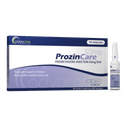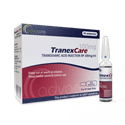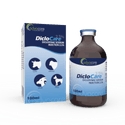- Home›
- Pharmaceuticals›
- Injections›
- Small Volume Injections›
- Furosemide Injection
Furosemide Injection
Dosage
Packaging
What is Furosemide?
Active Ingredients: Furosemide
Furosemide Injection is a drug used to treat hypertension (high blood pressure) by reducing extra fluid in the body. Fluid retention may be caused by conditions such as heart failure, liver disease, and kidney disease. Reducing excess fluid in the body will lessen symptoms such as shortness of breath and swelling.
Injections of Furosemide are typically given if oral medication is not possible or in emergency situations.
Furosemide is classified as a loop diuretic. It works by helping the kidneys get rid of extra salt and water.
The role of Furosemide is to inhibit the reabsorption of sodium and chloride. It has an effect on the proximal and distal tubules and also in the loop of Henle. That is why this drug has a high degree of action. The action on the distal tubule is due to the inhibitory effect on carbonic anhydrase and aldosterone. Diuresis occurs 5 minutes after intravenous administration and a bit longer after intramuscular administration. The peak effect is in the first 30 minutes, and the diuretic effect lasts approximately 2 hours. This medicine is bound to plasma proteins, mainly albumins. The terminal half-life of this drug is approximately 2 hours. Furosemide glucuronide is the only or the major biotransformation product of furosemide in man. The medication is excreted mainly in urine. Intravenous furosemide is recommended as an adjunctive therapy in acute pulmonary edema, and a rapid onset of diuresis occurs.
The binding to albumin is reduced in older patients. Furosemide is predominantly excreted in urine. The renal clearance in older healthy male individuals (60-70 years of age) is smaller than in younger healthy male individuals (20 to 35 years of age). The diuretic effect of furosemide is less in older patients than in younger patients. Patients with renal impairments might experience increased BUN, serum creatinine, and serum potassium levels. Weight gain has been noticed in patients with renal impairment who take NSAIDs.
This drug is also available in the form of a tablet.
AdvaCare Pharma's Furosemide Injections are manufactured in GMP-certified facilities located in China, India, and the USA. We routinely inspect our production facilities to ensure our products meet health, safety, and environmental standards.
Why are we a leading Furosemide manufacturer?
AdvaCare Pharma, a US-owned pharmaceutical company, is a manufacturer of Furosemide Injection with GMP-compliant manufacturing facilities located worldwide. We conduct frequent GMP, third-party and internal facility inspections to ensure that our manufactured injectable treatments exceed the stringent requirements of importing countries and our distributors.
As a renown Furosemide manufacturer and global supplier of 120+ pharmaceutical injection products, our global reach extends to over 65 markets ensuring that pharmaceutical distributors, hospitals, pharmacies, NGOs and government institutions receive the quality-assured treatments they need.
Uses
What is Furosemide used for?
It is used to treat hypertension and edema associated with:
- heart failure
- liver cirrhosis
- renal disease
- hypertension
- cirrhosis of the liver
- nephrotic syndrome
This drug acts on the kidneys and increases water loss from the body. This potent loop diuretic increases the excretion of Na+ and water by the kidneys. It works by inhibiting the reabsorption from the proximal and distal tubules and the loop of Henle. It has an effect on the nephron cells and modifies the content of the renal filtrate.
It is used for clinical settings that require a drug with a higher diuretic potential. This drug is most effective for patients who are unable to take oral medication and patients with emergency clinical situations.
How is a Furosemide Injection used?
This medication is manufactured as a solution to be given by injection into the vein or muscle. It should be administered by a healthcare professional in a hospital setting. When given intravenously, effects are seen within five minutes.
What dose should be given?
The usual dose for adults is 20-40mg, IV or IM.
The usual dose for children is 0.5-1mg/kg, IV or IM.
Refer to a doctor or pharmacist for guidelines on dosage. Do not exceed what they advise.
What should be done in cases of Furosemide overdose?
The most common signs and symptoms of Furosemide include the following extensions of the diuretic action:
- dehydration
- blood volume reduction
- hypotension
- electrolyte imbalance
- hypokalemia
- hypochloremic alkalosis
The concentration of Furosemide that leads to toxicity or death is unknown. The treatment consists of supportive therapy and replacement of excessive fluid and electrolyte losses. Patients who have symptoms of overdose should be closely monitored. Serum electrolytes, blood pressure, and carbon dioxide levels should be determined. Patients with urinary bladder outlet obstruction like prostatic hypertrophy should receive adequate drainage. In cases of Furosemide overdose, hemodialysis will not improve the patient’s condition.
Can Furosemide be used in pregnant women?
There is no data about Furosemide risks in pregnant women. Observational studies and case reports do not show any risk of major birth defects, miscarriage, or other adverse maternal or fetal outcomes with Furosemide treatment during pregnancy. Pregnant women with untreated congestive heart failure or liver cirrhosis can lead to adverse effects on the mother and the fetus. Pregnant women with congestive heart failure have an increased risk of pre-term birth. These women should be closely monitored for destabilization of their heart failure. Heart rate and stroke volume during the first trimester of the pregnancy might lead to maternal death or stillbirth. Pregnant women with liver cirrhosis should also be closely monitored because if left untreated, they can have a hepatic failure, pre-term delivery, variceal hemorrhage, maternal death, or fetal growth restriction. Doctors should carefully monitor the health status of the pregnant women and decide about adding Furosemide.
Animal studies show that Furosemide might lead to unexplained maternal deaths and abortions in rabbits. In general, all pregnancies have a background risk of birth defects, losses, or other adverse outcomes. Adding Furosemide during pregnancy in humans should be discussed with a pharmacist and a gynecologist. Adding any drug during pregnancy should outweigh the benefits.
Can Furosemide be used during lactation?
This drug can be found in human milk, but there is no data that shows adverse effects on the breastfed infant or effects on milk production. Doses of Furosemide should be properly adjusted because overdose might lead to significant diuresis that can affect normal milk production. This can also decrease the chances for possible developmental and health benefits of breastfeeding for the mother and the infant.
Can Furosemide be used in the pediatric population?
Premature infants with post-conceptual age less than 31 weeks should not take higher dosages than 1mg/kg/24 hours because they might develop plasma levels associated with potential toxic effects like ototoxicity.
When given during the first year of life in pre-term born patients, may lead to precipitation (nephrocalcinosis/nephrolithiasis).
Can Furosemide be used in the geriatric population?
There are no available well-controlled studies that prove the safety of Furosemide. Some clinical studies do not identify the responses in elderly and younger patients. Patients with hepatic, renal, or cardiac impairments should receive well-regulated dosages to avoid side effects. This drug is excreted by the kidney, and older patients with renal impairments might have negative side effects. During the treatment with Furosemide, patients with renal impairments should be monitored.
Other warnings
Patients who take Furosemide might experience symptoms from excessive fluid or electrolyte losses. Postural hypotension might occur and can be managed by getting up slowly. Patients who take Furosemide should take potassium supplements or should include more potassium dietary products to avoid hypokalemia.
Furosemide can potentially increase blood glucose levels and affect urine glucose tests.
The skin of some patients who take Furosemide might be more sensitive to sunlight while taking it.
Patients should avoid medications that increase blood pressure, including products for appetite suppression and cold symptoms.
Side Effects
As with all pharmaceuticals, some unwanted effects can occur from the use of Furosemide Injection.
Common side effects include, but may not be limited to:
- constipation
- diarrhea
- dizziness
- vomiting
- nausea
- headache
Serious side effects may include:
- signs of an allergic reaction
- lightheadedness
- muscle spasms
- changes in hearing
- hyperglycemia
- signs of kidney problems
Ototoxicity is a serious side effect that might occur in the pediatric population if the doses are not well adjusted.
For a comprehensive understanding of all potential side effects, consult a medical professional.
If any symptoms persist or worsen, or you notice any other symptoms, please call your doctor.
Precautions
Do NOT use Furosemide Injection if:
- You are allergic to furosemide or any of the other ingredients.
- You have anuria.
Furosemide Injection should not be given in large doses, rapidly, due to ototoxic effects. It can also lead to gout and hyperglycemia.
Too much of this medication can cause severe diuresis and electrolyte depletion.
Chronic alcohol consumption should be avoided during the treatment process with Furosemide. Consuming alcohol may increase the orthostatic hypotension.
Patients treated with Furosemide should increase the consumption of potassium-rich foods because Furosemide might lead to potassium depletion. Foods such as bananas and orange juice are particularly beneficial and should be included in the diet during the treatment with Furosemide. Patients should also avoid natural licorice because it might lead to hypokalemia.
Before treatment, consult your doctor regarding any medications you are taking to address potential drug interactions.
This medication may not be suitable for people with certain conditions, so it is important to consult with a doctor if you have any health conditions.
Furosemide 40mg: Why the most common dose?
Furosemide 40mg is commonly used for its potent diuretic effect, which is essential for treating edema and hypertension. Lower doses like Furosemide 20mg may be used initially, while higher doses are reserved for more severe fluid retention.
References
Diuretic efficacy of high dose furosemide in severe heart failure: Bolus injection versus continuous infusion
The objective of this study was to evaluate the efficacy of high-dose furosemide as a continuous infusion compared with a bolus injection of equal doses in patients with severe heart failure.
This is a randomized crossover study that compares the efficacy of a continuous infusion of high-dose furosemide (mean daily dosage 690mg, range 250 to 2,000) versus a single bolus injection of an equal dose in 20 patients with severe heart failure.
Patients received an equivalent dosage either through a single intravenous bolus injection or via an 8-hour continuous infusion following a loading dose (20% of total dosage). The mean (±SEM) daily urinary volume was significantly higher after continuous infusion (2,860 ± 240ml) compared to bolus injection (2,260 ± 150 ml, p = 0.0005), as was sodium excretion (210 ± 40mmol with infusion vs. 150 ± 20 mmol with bolus, p = 0.0045), despite significantly lower urinary furosemide excretion (310 ± 60mg every 24 hours with infusion vs. 330 ± 60mg every 24 hours with bolus, p = 0.0195). The maximum plasma furosemide concentration was significantly higher with bolus injection (95 ± 20μg/ml) than during continuous infusion (24 ± 5μg/ml, p < 0.0001).
The findings suggest that patients with severe heart failure can benefit from a high dose of furosemide administered as a continuous infusion and it is more efficacious than bolus injection.
You might be interested in...
Why AdvaCare Pharma?
As an industry leader, we are aware of our responsibility to provide affordable and sustainable solutions to improve healthcare worldwide.













